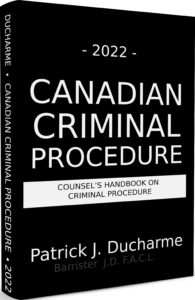 |
| Patrick Ducharme |
Only in the case of section 469 offences is the accused required to make an application for bail. In all but arrests for section 469 offences, the accused will immediately and automatically be entitled to a bail hearing. Section 469 contains a list of the most serious offenses that can be committed in Canada.
Anyone charged with one of these offences must apply for release from custody. The hearing will be before a Judge of the Superior Court. Counsel on behalf of the accused is required to provide specific material for an application seeking release in relation to a 469 offence. One of the requirements is an affidavit by the accused providing specific information about his life circumstances and prior convictions.
Bail hearings are also known as and described officially as “judicial interim release” hearings. There are, of course, several ways to compel a person’s appearance in court without the need for an arrest and release via a judicial interim release hearing. An accused person may be summonsed to court or receive an appearance notice or promise to appear.1 When an accused is arrested, with or without a warrant, and is not released by the arresting officer or an officer in charge, or any other police officer, there will be a judicial interim release hearing.
A police officer who believes on reasonable grounds that an accused has contravened, or, is about to contravene, any release order may arrest the accused without warrant.
If the prosecutor proves a contravention of release conditions on a balance of probabilities the court is required to revoke the original release order and conduct a new hearing where the accused bears the onus, on a balance of probabilities, to “show cause” why detention is not necessary. In effect, the accused will then be detained in custody unless he, having been given a reasonable opportunity to do so, shows cause why his detention in custody is not justified within the meaning of subsection 515(10).
Although the accused may not be examined by the Justice or the prosecutor respecting the offence the accused is facing, generally, there is one very important exception to this rule. The accused shall not be examined by the Justice or the prosecutor unless the accused himself testifies respecting the offence. If he does, he may be examined or cross-examined by either the Justice or the prosecutor or both. The accused is seldom prepared to defend himself against the allegations at this early stage of a judicial interim release hearing. It is generally wise that the accused not make any reference to the specific circumstances of the offence(s) before the court.
Section 522 provides that for an accused charged with an offence that is listed in section 469, no Judge or Justice, other than a Judge presiding in the Superior Court of criminal jurisdiction for the province may release the accused. Further, the onus is on the accused to show cause why her detention is not justified. For these serious offences an application must be brought by the accused to have the court consider a release order. The Superior Courts of the Provinces and Territories have promulgated their own rules to be followed when making a judicial interim release application.
Any order made pursuant to section 522 is reviewable only under section 680 of the Code. Section 680 of the Code gives the Court of Appeal jurisdiction to entertain applications to review bail applications. In order to obtain a review by the court under this provision, the Chief Justice must order a review.
The Court of Appeal may, on the direction of the Chief Justice or acting Chief Justice review an order made by a Superior Court Justice relating to bail. The Court of Appeal may, if it does not confirm the decision made by the Superior Court Justice, vary the decision or substitute such other decision as, in its opinion, should have been made.
The Supreme Court of Canada has ruled that a panel conducting a review must show deference to the Judge’s findings of fact, but may substitute its decision for that of the Judge where it is satisfied that the Judge erred in law or in principle, and the error was material to the outcome. On consent of the parties, the powers of the Court of Appeal may be exercised by a single Judge of that court rather than a three-person panel.
Some appellate decisions have addressed the threshold that must be met before a review is ordered. In Cooper8 the Alberta Court of Appeal held that section 680 is silent as to the test governing the decision whether to permit a review. The test should be that the Chief Justice brings his or her best judgment to bear on whether the appeal has arguable merit. Such a test enjoys the advantage of permitting the rejection of cases that are entirely devoid of merit, while permitting those that, in the opinion of the Judge, are worthy of consideration for review.
In R. v. T.(G.J.) the Newfoundland Court of Appeal held that where a bail review in a murder case is brought on the basis of a change in circumstances, the application should be brought under section 522(1) of the Code rather than section 680. The court held that section 680 applications are only appropriate when a challenge is made directly to the initial order made on the evidence before it at the time.
The Court of Appeal for Ontario in R. v. Whyte10 decided that where the applicant disputes the correctness of a bail decision the proper course is to seek review by section 680. When an applicant concedes the validity of the bail decision but seeks a review based on a change in circumstances, the appropriate course is to bring a second bail review application in the Superior Court. This application would return the matter to the originating court, thus creating an evidentiary record and an opportunity for the Judge of first instance to consider the impact, if any, of new or changed evidence.

The above is the an excerpt of Patrick J Ducharme's book, Canadian Criminal Procedure, available at Amazon or in bulk through MedicaLegal Publishing along with Criminal Trial Strategies.
Subscribe to Patrick Ducharme's Youtube Channel
